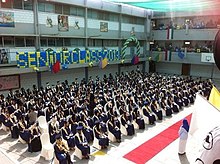
Back التعليم في الكويت Arabic Küveytdə təhsil Azerbaijani কুয়েতের শিক্ষাব্যবস্থা Bengali/Bangla 쿠웨이트의 교육 Korean Pendidikan di Kuwait Malay การศึกษาในประเทศคูเวต Thai
This article needs additional citations for verification. (July 2023) |
| Ministry of Education | |
|---|---|
| National education budget (2022) | |
| Budget | $7.33 billion (4.0% of GDP) (public only)[1] |
| General details | |
| Primary languages | Arabic |
| System type | Public and private |
| Literacy | |
| Male | 97%[3] |
| Female | 96%[2] |
| Enrollment | |
| Total | 658,868[4] |
| Primary | 345,501 |
| Secondary | 313,367 |

The State of Kuwait, located at the head of the Persian Gulf, supports an educational policy that seeks to provide an opportunity to all children, irrespective of their social class, including children with special needs.[5] Kuwait was ranked 63rd on the Human Development Index report for 2011 by the United Nations Development Programme, placing Kuwait above the regional average.[6]
According to 2017 data from UNESCO, the literacy rate stood at 96.3% for Kuwaitis aged 25–64, compared to 80% across the MENA region. In 2017 99.9% of Kuwaitis aged, 15–24 were literate, while the MENA average was 89.6% in 2016. Moreover, according to World Bank statistics from 2015, among Kuwaitis 15 and older, females have caught up to and surpassed their male peers on this metric of educational attainment, which stands, for the respective sexes, at 99.4% and 96.4%.
The education system in Kuwait has celebrated numerous achievements on a global scale; in the year ending 2006, thirteen percent of all public expenditure was given to education, comparable to many OECD countries. As a percentage of GDP, at 15 percent, Kuwait is currently above the OECD average.
Kuwait has the highest literacy rate in the Arab world. In 2005, the literacy rate of Kuwait was 94 percent.[7] The Ministry of Education is also making efforts to incorporate women into the educated workforce through various programs; for instance, the 1989 initiative to establish daytime literacy clinics for women.[8]The Kuwaiti government offers scholarships to students who are accepted in universities in the United States, the United Kingdom and other foreign academic institutions.[8]
- ^ "Kuwait National Budget, 2022/2023". Kuwait National Gazette (accessed via search.kna.kw).
- ^ "The World Factbook". Cia.gov. Retrieved 13 September 2016.
- ^ "Literacy rate. 2018".
- ^ Central Statistical Bureau. Kuwait Education Statistics, 2018/2019
- ^ "State of Kuwait, Ministry of Education."National Report on the Development of Education 2004–2008." pp15" (PDF). Archived from the original (PDF) on 2017-07-11. Retrieved 2009-06-23.
- ^ "United Nations,Human Development Indicators Country Profile". Archived from the original on 2012-04-19. Retrieved 2012-03-20.
- ^ "CIA World Factbook. Based on 2005 census".
- ^ a b "Embassy of the Kuwait, Cultural Office". Archived from the original on 2009-04-13. Retrieved 2009-06-23.
© MMXXIII Rich X Search. We shall prevail. All rights reserved. Rich X Search